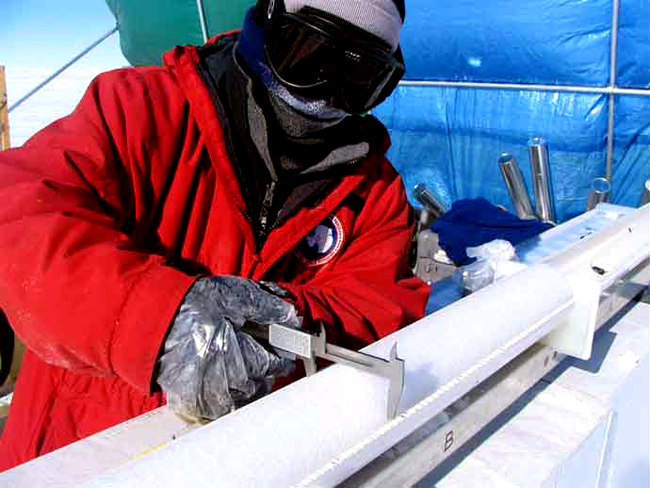|
High-resolution recordITASE scientists reconstruct recent Antarctic climate in unprecedented detailPosted March 28, 2008
One might be forgiven for assuming Antarctica is one uniform block of ice given a superficial view from an airplane. The white horizon seems to stretch on forever, occasionally interrupted by mountain peaks, appearing like rough speed bumps on its smooth surface. But scientists interested in the physical processes that drive the continent’s dynamic ice flow see a different picture. Zooming in with the use of satellites and radars, they find dramatic changes in ice mass at the edges, particularly in West Antarctica. On the ground, they can take ice cores that will tell them about past climate by analyzing various properties like density and chemical composition. Researchers involved in the United States component of the International Trans-Antarctic Scientific Expedition (ITASE) make use of all these tools and more as they attempt to reconstruct the continent’s climatic history over the last 200 to 1,000-plus years. Their goal is to create a season-by-season record of environmental change for Antarctica, taking it from the least-understood continent to the most-understood one on the planet for the last several hundred years. And they’re rapidly approaching that goal, according to Paul Mayewski, the principal investigator for ITASE. “Antarctica is so well suited [for understanding climate] because literally anywhere you go you can recover an ice core,” he explained. “We have … buried archives lying around anywhere we [can] extract them and analyze them.” U.S. ITASE scientists have made six traverses across parts of the continent since 1999 — four in West Antarctica and two in East Antarctica — collecting more than 40 ice cores and many gigabytes of radar data. Twenty-one nations now comprise ITASE, many of them conducting their own overland journeys as they cooperatively build this unprecedented database. “ITASE is an important international activity, which brings together scientists from most of the [Scientific Committee on Antarctic Research] nations, and it has become a central focus of much of the recent shallow ice coring activity around the continent,” noted Julie Palais, glaciology program manager at the National Science Foundation’s Office of Polar Programs. “In addition, ITASE traverses are an important component of the on-going International Polar Year activities being supported by the U.S. and other countries,” she added. Mayewski and his team started their most recent traverse expedition during the 2006-07 austral season after a three-year hiatus. (See related story: Scientists traverse East Antarctica for ice cores.) The self-supported journey by farm tractor and sled began at Taylor Dome, an ice ridge that rises about 2,400 meters above sea level. Equipment snafus limited the team to about 460 kilometers that season, but it got back on track this past summer, arriving at the South Pole on Christmas Eve 2007. “Basically, this year we were able to get back to our old mode of operation,” said Brian Welch, a researcher from St. Olaf College in Minnesota, who operated the team’s deep radar system. The deep radar can peer down 3,500 meters to the bedrock beneath the ice sheet. “It was nice to finish this series of six seasons off, and this second of two seasons, with a nice, straightforward program,” added Mayewski, director of the Climate Change Institute at the University of Maine and founder of the 21-nation ITASE effort. “Things went very well this year, the way they have characteristically for most of our projects.” The scientists have much to analyze, but they can make some general statements about their findings, the foremost that the interior surface regions of Antarctica haven’t changed much in the centuries they targeted. “Temperature, precipitation and circulation systems that get in there are probably still within the range of variability within the last few hundred years,” Mayewski said. “As you go out to the coastal areas, however, or if you go into the ocean or go into the winter atmosphere above Antarctica, they’re all indicating warming.” |



For USAP Participants |
For The Public |
For Researchers and EducatorsContact UsNational Science FoundationOffice of Polar Programs Geosciences Directorate 2415 Eisenhower Avenue, Suite W7100 Alexandria, VA 22314 Sign up for the NSF Office of Polar Programs newsletter and events. Feedback Form |


